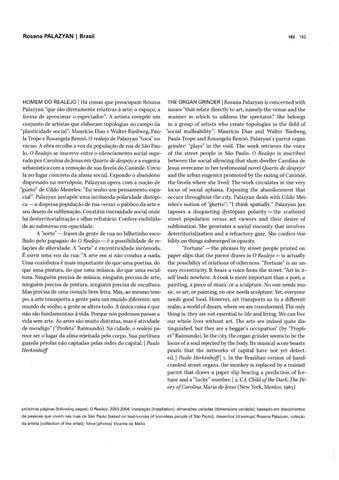Rosana PALAZYAN
I Brasil
182
183
HOMEM DO REALEJO I Há coisas que preocupam Rosana THE ORGAN GRINDER I Rosana Palazyan is concerned with Palazyan "que são diretamente relativas à arte: o espaço, a issues "that relate directly to art, namely the venue and the forma de aproximar o espectador". A artista compõe um manner in which to address the spectator:' She belongs conjunto de artistas que elaboram topologias no campo da in a group of artists who create topologies in the field of "plasticidade social": Maurício Dias e Walter Riedweg, Pau- "social malleability": Maurício Dias and Walter Riedweg, la Trope e Rosangela Rennó. O realejo de Palazyan "toca" no Paula Trope and Rosangela Rennó. Palazyan' s parrot organ vácuo. A obra recolhe a voz da população de rua de São Pau- grinder1 "plays" in the void. The work retrieves the voice lo. O Realejo se inscreve entre o silenciamento social supe- of the street people in São Paulo. O Realejo is inscribed rado por Carolina de Jesus em Quarto de despejo e a eugenia between the social silencing that slum dweller Carolina de urbanística com a remoção de sua favela do Canindé. Circu- Jesus overcame in her testimonial novel Quarto de despej 0 2 la no lugar concreto da afasia social. Expondo o abandono and the urban eugenics promoted by the razing of Canindé, dispersado na metrópole, Palazyan opera com a noção de the favela where she lived. The work circulates in the very ''gueto'' de Cildo Meireles: "Eu tenho um pensamento espa- locus of social aphasia. Exposing the abandonment that cial". Palazyan justapõe uma incômoda polaridade distópi- occurs throughout the city, Palazyan deals with Cildo Meica - a dispersa população de rua versus o público da arte e reles's notion of ''ghetto'': "I think spatially." Palazyan juxseu desejo de sublimação. Constitui viscosidade social onde taposes a disquieting dystopian polarity - the scattered há desterritorialização e olhar refratário. Confere visibilida- street population versus art viewers and their desire of de ao submerso em opacidade. sublimation. She generates a social viscosity that involves A "sorte" - frases da gente de rua no bilhetinho esco- deterritorialization and a refractory gaze. She confers visilhido pelo papagaio do O Realejo - é a possibilidade de re- bility on things submerged in opacity. lações de alteridade. A "sorte" é excentricidade incômoda. "Portune" - the phrases by street people printed on É ouvir uma voz da rua: "A arte em si não conduz a nada. paper slips that the parrot draws in O Realejo - is actually Uma cozinheira é mais importante do que uma poetisa, do the possibility of relations of otherness. "Portune" is an unque uma pintura, do que uma música, do que uma escul- easy eccentricity. It hears a voice from the street: ''Art in ittura. Ninguém precisa de música, ninguém precisa de arte, self leads nowhere. A cook is more important than a poet, a ninguém precisa de pintura, ninguém precisa de escultura. painting, a piece of music or a sculpture. No one needs muMas precisa de uma comida bem feita. Mas, ao mesmo tem- sic, or art, or painting, no one needs sculpture. Yet, everyone po, a arte transporta a gente para um mundo diferente, um needs good food. However, art transports us to a different mundo de sonho, a gente se altera todo. A única coisa é que realm, a world of dream, where we are transformed. The only não são fundamentais à vida. Porque nós podemos passar a thing is, they are not essential to life and living. We can live vida sem arte. As artes são muito distintas, mas é atividade our whole lives without art. The arts are indeed quite disde mendigo" ("Profeta" Raimundo). Na cidade, o realejo pa- tinguished, but they are a beggar's occupation" (by "Prophrece ser o lugar da alma rejeitada pelo corpo. Sua partitura et" Raimundo). In the city, the organ grinder seems to be the guarda pérolas não captadas pelas redes do capital. I Paulo lo cus of a soul rejected by the body. Its musical score boasts Herkenhoff pearls that the networks of capital have not yet detected.1 Paulo Herkenhoffl1. In the Brazilian version of handcranked street organs, the monkey is replaced by a trained parrot that draws a paper slip bearing a prediction of fortune and a "lucky" number. I 2. C.f. Child of the Dark: The Diary of Carolina Maria de Jesus (New York, Mentor, 1963)
próximas páginas [following pages]: O Realejo, 2003-2004; instalação [installation]; dimensões variadas [dimensions variable]; baseado em depoimentos de pessoas que vivem nas ruas de São Paulo [based on testimonies of homeless people of São Paulo]; desenhos [drawings] Rosana Palazyan; coleção da artista [collection of the artist]; fotos [photos] Vicente de Mello
